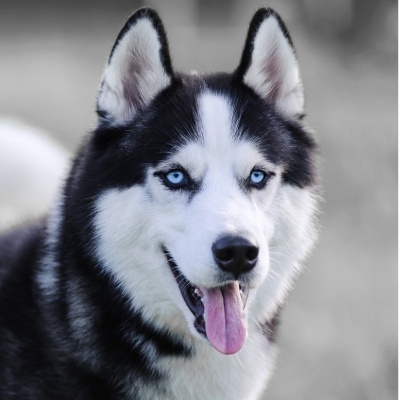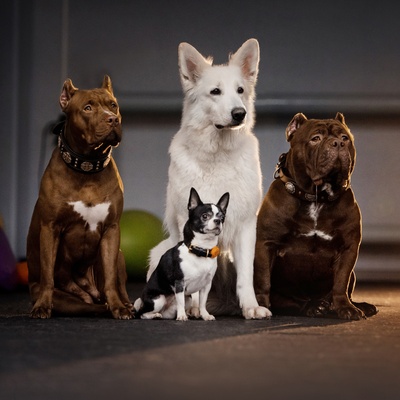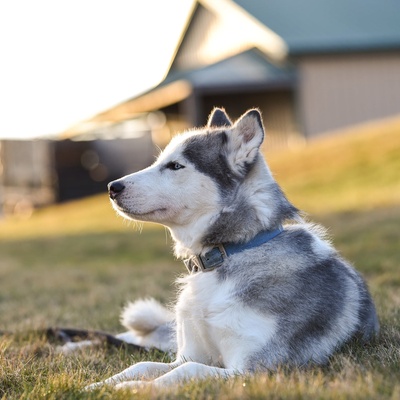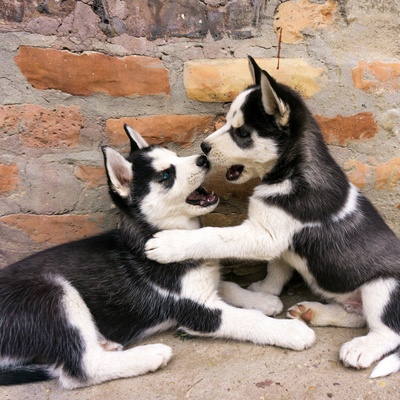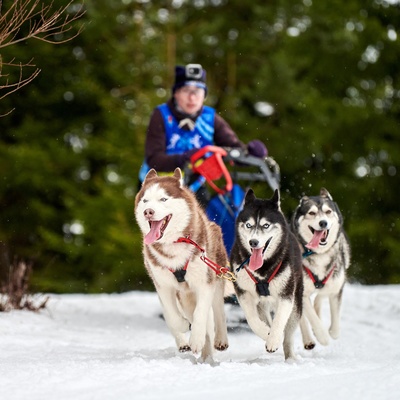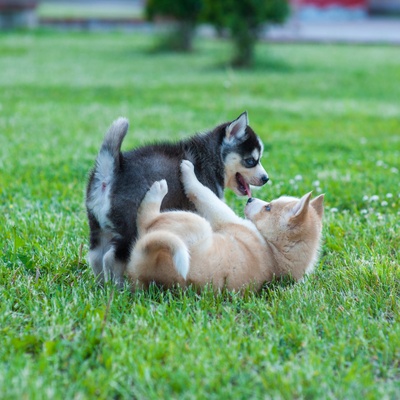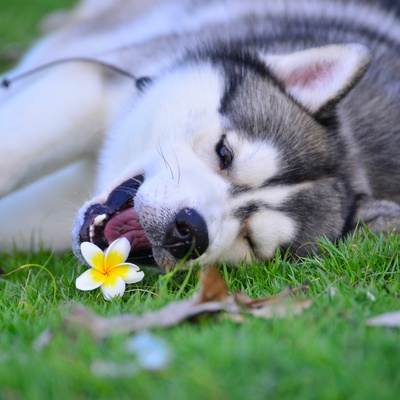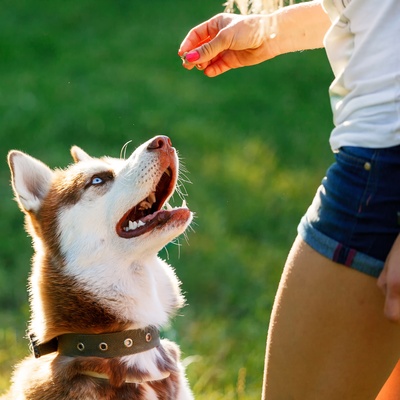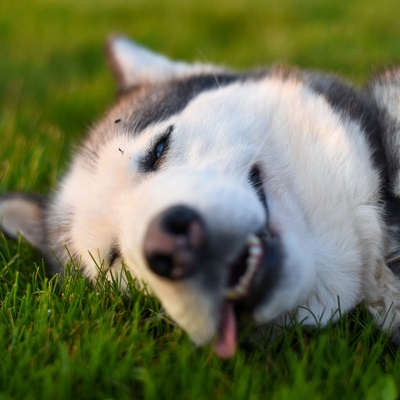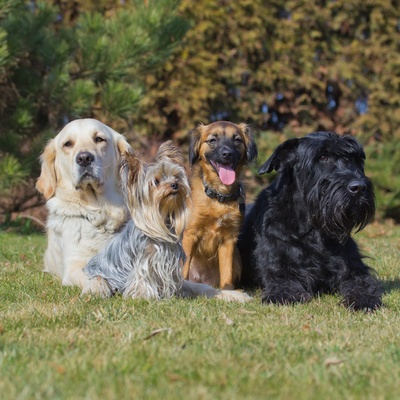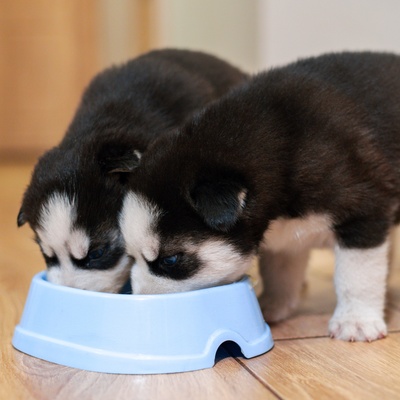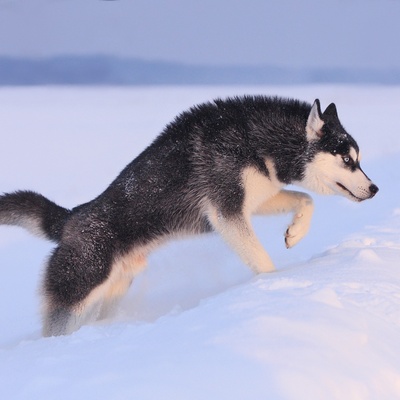Introducing the Siberian Husky
Discover all there is to know about the Siberian Husky : its characteristics, behavior, training, and its cost.

Discover all there is to know about the Siberian Husky : its characteristics, behavior, training, and its cost.
The Siberian Husky, with its origins in the cold, harsh climates of Siberia, is a breed that epitomizes endurance and resilience. Developed by the Chukchi people for sled-pulling, herding, and companionship, these dogs quickly became renowned for their incredible stamina and good-natured temperament. Today, the Siberian Husky is celebrated worldwide, not only for its striking appearance, characterized by its wolf-like features and mesmerizing blue or multi-colored eyes but also for its versatile abilities.
This section presents the distinctive characteristics of the Siberian Husky breed.
The Siberian Husky is part of the working group (group 2). These dogs are renowned for their intelligence and hard-working nature.
The Siberian Husky is a medium to large-sized dog, generally standing between 20 to 24 inches at the shoulder and weighing around 35 to 60 pounds.
Siberian Huskies have a medium-length double coat, providing excellent insulation against cold weather.
Siberian Huskies are known for their diverse range of coat colors, including black, gray, red, and agouti, often combined with white.
Siberian Huskies are adaptable to various living environments but thrive best in areas where they can exercise freely.
Siberian Huskies are highly sociable and friendly, often enjoying the company of people and other dogs. They are generally good with children.
They are a healthy and robust breed, but they can be predisposed to certain genetic conditions such as hip dysplasia and eye problems.
Siberian Huskies are intelligent and independent. They respond best to training that is consistent, patient, and positive.
We can help!
Every dog has its own character, and so do you. Making the right choice will ensure his well-being and yours.
Take our quiz to find out which breed is right for you, based on your personality, lifestyle, location and many other criteria.
Don't wait any longer and take the quiz to find out the answer!
The Siberian Husky is a medium-sized dog that exemplifies a balance of power, speed, and endurance.
Siberian Huskies are moderately sized, with females typically standing between 20 to 22 inches tall and males reaching up to 23 to 24 inches. In terms of weight, females usually range from 35 to 50 pounds, while males can weigh between 45 to 60 pounds.
The growth of Siberian Husky puppies is relatively rapid, with most reaching near adult size within their first year. However, they continue to fill out and mature, reaching their full adult size and weight by the age of 18 months to 2 years.
The Siberian Husky is adorned with a medium-length double coat that is both functional and visually striking. The topcoat is straight and somewhat smooth, while the undercoat is dense and soft, providing excellent insulation against cold climates. This breed's coat is known for its ability to withstand extreme weather conditions, offering protection from both cold and heat.
The Siberian Husky's coat presents a fascinating variety of colors and patterns. Common colors include black and white, gray and white, red and white, and pure white. Unique markings and striking contrasts are characteristic of the breed.
Siberian Huskies have a coat that requires regular maintenance due to its thickness and length. They shed moderately throughout the year and heavily during the shedding seasons in spring and fall. To manage shedding and keep their coat in good condition, regular brushing, at least once a week, is essential. During shedding seasons, more frequent brushing, possibly daily, can help control the amount of loose fur.
While Siberian Huskies are relatively clean and may not require frequent baths, occasional bathing every few months can help keep their coat healthy and reduce any doggy odor. It's important to use a mild dog shampoo to protect their skin and coat.
One of the most striking features of the breed is their eyes, which are almond-shaped and can range in color from deep blue to warm brown, and even heterochromia is common, where each eye is a different color. The ears of the Husky are medium-sized, triangular, and set high on the head, adding to their attentive and intelligent appearance.
They are extremely loyal and affectionate, making them wonderful companions for families and individuals alike.
There are over 400 recognized dog breeds, categorized into various groups based on their traits and purposes. The Siberian Husky belongs to the working group which falls under the group 2, which includes breeds known for their strength, intelligence, and versatility in performing tasks. This group encompasses breeds such as the Alaskan Malamute, Bernese Mountain Dog, and Great Pyrenees, among others.
They are typically strong, intelligent, and capable of independent thinking, making them invaluable in various roles. The Siberian Husky, in particular, stands out for its remarkable endurance, intelligence, and friendly nature. Originally bred as sled dogs, they are adept at working in harsh environments and are known for their cooperative team spirit.
The Siberian Husky is celebrated for its friendly and independent character. Known for their intelligence and playful nature, Huskies often exhibit a balance between independence and a strong desire for companionship.
They form deep bonds with their owners, displaying affection through playful antics and close proximity. While they cherish human interaction, they also have a free-spirited nature that requires understanding and respect from their owners. A present and attentive owner is crucial for the healthy development of a Husky, as they thrive on interaction, exercise, and mental stimulation.
Siberian Huskies are renowned for their sociability and approachable demeanor. They generally get along well with humans, including strangers, making them excellent family pets. Their friendly nature extends to children, with whom they often form special bonds, exhibiting patience and playfulness.
Huskies are also known for their good temperament with other dogs, though early socialization is key to nurturing this trait. Due to their pack mentality, Huskies enjoy the company of other dogs and can integrate well into multi-pet households. It's important to introduce them to a variety of people and animals from a young age to ensure they develop well-rounded social skills.
The Siberian Husky is remarkably adaptable and can thrive in various living environments, from apartments to spacious homes, and in both urban and rural settings. However, regardless of their living situation, they require dedicated attention and engagement from their owners to stay happy and healthy.
Due to their energetic nature, Huskies need ample exercise, with recommended daily walks totaling at least an hour, ideally split into two or more sessions. This exercise is crucial not only for their physical health but also for mental stimulation.
While Siberian Huskies can adjust to different living conditions, they particularly benefit from access to outdoor spaces where they can explore and expend their abundant energy. A secure yard or garden provides an ideal environment for them to run, play, and satisfy their innate curiosity. Due to their history as sled dogs, Huskies have a natural inclination to roam and explore, making a safe and enclosed outdoor area important for preventing escapes.
Additionally, regular opportunities for off-leash exercise in secure environments are beneficial for their overall well-being, allowing them to express their natural behaviors and tendencies fully.
The Siberian Husky is a breed that combines intelligence with an independent spirit, making training an interesting challenge. They learn quickly and can understand a variety of commands, but their independent nature sometimes leads to selective listening.
To effectively train a Husky, it's essential to establish yourself as the leader with a firm yet gentle approach. Positive reinforcement techniques, such as treats and praise, work best. Due to their tendency to roam, equipping a Husky with a GPS collar, like those offered by Weenect, is a wise precaution to prevent losses or escapes, especially in open areas.
Siberian Huskies have a strong pack instinct, which can be leveraged in training to encourage cooperation and listening. They respond well to consistent, clear communication and enjoy interactive training sessions that involve play and mental stimulation. It's important to start training and socialization early, exposing them to various people, animals, and environments to develop well-rounded social skills.
Huskies thrive on companionship and will often mirror the energy and enthusiasm of their trainer, making training sessions not only effective but also an enjoyable bonding experience.
Take the test and find out the dog breed that matches your personality and lifestyle.
Regular daily care is essential to maintain their well-being and to prevent common diseases and infections that could affect this breed.
Siberian Huskies are typically a hardy breed with good overall health. However, like all breeds, they have predispositions to certain health issues. Common concerns include hip dysplasia, eye problems such as cataracts and progressive retinal atrophy, and skin conditions. Symptoms vary depending on the condition but can include limping, vision impairment, or skin irritation.
The typical lifespan for a Siberian Husky is between 12 to 15 years, and with proper care, they can enjoy a healthy and active life.
Routine veterinary care is crucial throughout a Siberian Husky's life. Regular check-ups, vaccinations, deworming, and parasite control are essential for preventing illnesses. Daily care practices include regular brushing of their coat to manage shedding, cleaning their ears to prevent infections, and taking care of their dental hygiene to avoid tartar buildup.
Nail trimming is also important for their comfort and mobility. Being aware of potential allergies is key, and consulting a vet for dietary and environmental recommendations can help manage any sensitivities. The Siberian Husky is not a hypoallergenic breed.
A balanced diet rich in proteins and vitamins is crucial for their health and well-being. For Huskies with higher activity levels or additional protein requirements, supplementing their diet with lean red or white meats can be beneficial. However, it's important to limit the fat content in their diet to prevent weight gain and maintain their lean physique. Huskies have a relatively efficient metabolism and may require less food than expected for their size, so it's crucial to monitor their portion sizes and avoid overfeeding.
The Siberian Husky is a well-regarded breed known for its striking appearance and friendly nature. It's important to consider several factors before adopting.
When considering the adoption of a Siberian Husky, it's crucial to make an informed decision.
Visiting the breeder's premises allows you to assess the living conditions of the dogs and observe their behavior. It's important to inquire about the health of the puppy and its parents. Reputable breeders should provide transparent information about the puppy's health status and any hereditary illnesses in its lineage.
Lastly, you must have your dog microchipped by the age of 8 weeks old and have their details registered on a relevant database like Petlog or Animal Tracker. This is a legal requirement in Great Britain and you could face a £500 fine if you don't comply. Your vet can microchip your dog for a small fee, alternatively, any Blue Cross center will do it for free.
The acquisition cost of a Siberian Husky can vary based on several factors, such as the dog's lineage, pedigree, the reputation of the breeder, and the dog's age. The price range for a Siberian Husky puppy typically ranges from
to
. It's important to remember that owning a Siberian Husky involves ongoing costs for their care, including food, veterinary expenses, and grooming.
The annual expense for maintaining a Siberian Husky is estimated to be around
to
, depending on the specific needs and lifestyle of the dog.
Choosing a dog that matches your personality and lifestyle will ensure your well-being and his!
To access the most relevant information, suitable payment methods, and delivery in your region, please select the website corresponding to your country.
